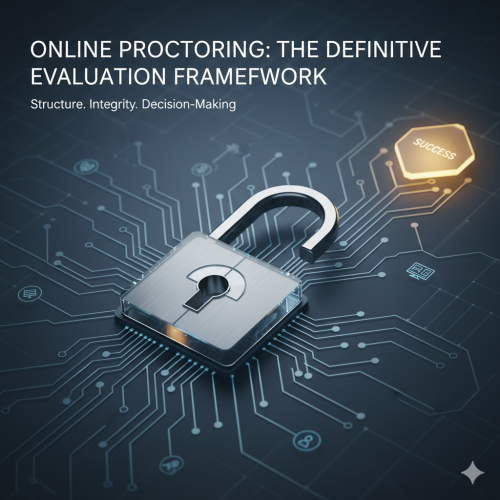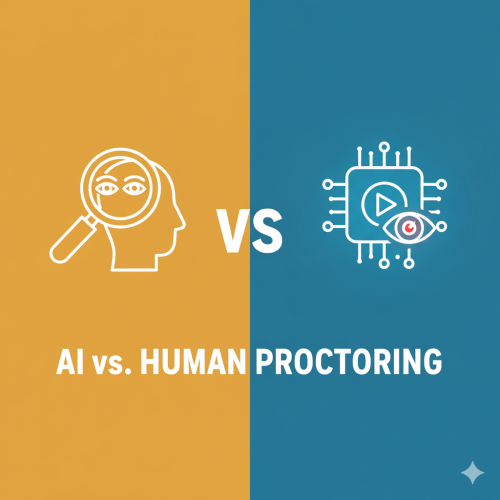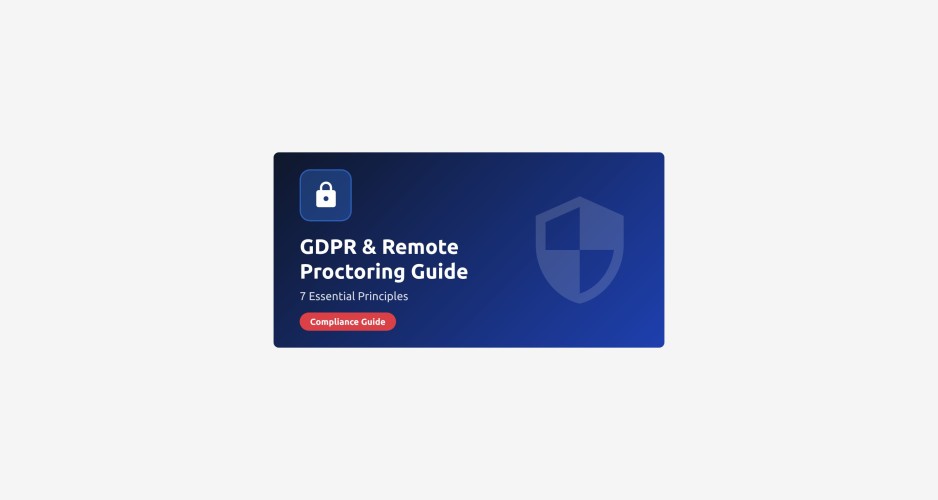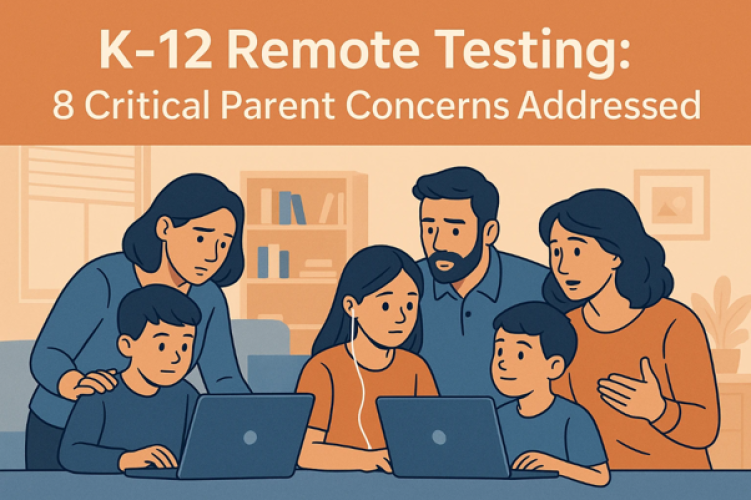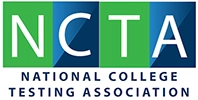Introduction: The Evolution of Educational Assessment
The landscape of educational assessment in India has undergone dramatic transformation over the past decade. As institutions embrace digital learning and remote education becomes mainstream, the need for secure, scalable, and efficient examination systems has never been more critical.
Traditional in-person proctoring, while reliable, presents significant challenges in terms of scalability, cost, and accessibility. AI-powered proctoring solutions are emerging as a practical answer to these challenges, enabling institutions to conduct secure examinations at scale while maintaining academic integrity.
The Numbers Tell the Story:
- Online education enrollment in India has grown significantly across universities and colleges
- Educational institutions are increasingly adopting hybrid learning models
- The demand for flexible examination solutions continues to rise across sectors
This article explores how AI proctoring technology works, its benefits for Indian educational institutions, and what to consider when evaluating these solutions.
Understanding AI Proctoring Technology
What is AI Proctoring?
AI proctoring uses artificial intelligence and machine learning algorithms to monitor online examinations in real-time or through post-exam analysis. Unlike traditional proctoring that requires human supervisors to physically oversee students, AI proctoring systems can monitor hundreds or thousands of test-takers simultaneously.
Core Technologies Behind AI Proctoring
1. Computer Vision and Facial Recognition
- Verifies test-taker identity at the start of the exam
- Monitors face position during the test
- Detects if multiple people appear in the camera frame
- Identifies unusual head movements or gaze patterns
2. Audio Analysis
- Flags suspicious audio patterns (conversations, external voices)
- Differentiates between normal sounds and potential cheating indicators
3. Behavioral Analytics
- Tracks typing patterns and keystroke dynamics
- Monitors mouse movements and click patterns
4. Browser and Device Monitoring
- Locks down browser to prevent tab switching
- Detects attempts to access unauthorized applications
- Monitors screen sharing
- Prevents copy-paste functions during examination
The Multi-Layered Approach to Exam Security
Modern AI proctoring solutions don't rely on a single detection method. Instead, they employ a multi-layered security approach:
Layer 1: Identity Verification
Before the exam begins, the system verifies the test-taker's identity through:
- Photo ID comparison
- Facial biometric matching
- Live photo capture
- Room scanning protocols
Layer 2: Real-Time Monitoring
During the examination, AI algorithms and systems continuously analyze:
- Video feed from the candidate's webcam
- Audio from the microphone
- Screen activity and application usage
- Browser behavior and navigation attempts
Layer 3: Intelligent Flagging
Rather than immediately terminating exams, sophisticated AI systems:
- Assign risk scores to various behaviors
- Flag suspicious activities for review
- Prioritize high-risk incidents for immediate attention
- Create comprehensive audit trails
Layer 4: Post-Exam Analysis
After examination completion:
- Review flagged incidents with context
- Allow human proctors to make final determinations
- Generate detailed examination reports
- Provide analytics for institutional review
This layered approach reduces false positives while maintaining robust security standards.
Benefits for Indian Educational Institutions
1. Scalability Without Infrastructure Burden
Indian universities often face the challenge of conducting examinations for thousands of students across multiple locations. AI proctoring enables:
- Simultaneous monitoring of unlimited test-takers
- No physical infrastructure requirements
- Reduced need for large examination halls
- Flexibility to conduct exams across time zones
Example Scenario: A university with 50,000 students can conduct semester exams remotely without requiring 1,000+ physical proctors or dozens of examination centers.
2. Cost Efficiency
Traditional examination administration involves significant costs:
- Examination hall rentals
- Proctor salaries and training
- Logistics and coordination
- Security and supervision staff
AI proctoring can reduce these costs by:
- Eliminating physical venue requirements
- Reducing human proctor needs
- Streamlining administrative processes
- Minimizing examination day logistics
3. Accessibility and Flexibility
For students across India's diverse geography:
- Students in remote locations can take exams from home
- No travel costs or time requirements
- Accommodation for students with disabilities
- Flexible scheduling options for working professionals
4. Enhanced Academic Integrity
AI proctoring provides:
- Consistent monitoring standards across all test-takers
- Comprehensive documentation of exam sessions
- Reduced human bias in violation detection
- Detailed evidence for academic integrity reviews
5. Data-Driven Insights
Modern proctoring systems generate valuable analytics:
- Examination behavior patterns
- Common violation trends
- Test difficulty indicators
- Student stress and engagement levels
These insights help institutions improve exam design and administration.
Addressing Common Concerns
Privacy and Data Security
Legitimate concerns exist about student privacy. Responsible AI proctoring solutions should:
- Comply with data protection regulations
- Implement end-to-end encryption
- Provide transparent data usage policies
- Allow students to understand what's being monitored
- Delete recorded data after appropriate retention periods
Technology Access and Digital Divide
Not all students have equal access to technology. Institutions implementing AI proctoring should:
- Provide minimum system requirement guidelines
- Offer device lending programs where possible
- Maintain alternative examination options
- Consider bandwidth limitations in rural areas
False Positives and Student Stress
AI systems can sometimes flag innocent behaviors. Best practices include:
- Clear communication of examination rules
- Practice sessions before actual exams
- Human review of all flagged incidents
- Appeals processes for students
- Contextual analysis rather than automatic penalties
Cultural and Environmental Considerations
Indian homes present unique challenges:
- Joint family living situations
- Limited private space for examinations
- Variable internet connectivity
- Different lighting conditions
Effective AI proctoring systems must account for these realities through:
- Flexible room scanning requirements
- Tolerance for background activity
- Bandwidth-optimized video streaming
- Clear guidelines for test environment setup
The Future of AI Proctoring in India
Emerging Trends
1. Hybrid Proctoring Models Combining AI monitoring with selective human oversight for high-stakes examinations.
2. Adaptive Security Systems that adjust monitoring intensity based on exam importance and student behavior patterns.
3. Integration with Learning Management Systems Seamless connection between course platforms and proctoring solutions.
4. Advanced Biometric Authentication Voice recognition, keystroke dynamics, and behavioral biometrics for enhanced identity verification.
5. Accessibility Features Better accommodation for students with disabilities through customizable monitoring parameters.
Regulatory Evolution
As online examination adoption grows, expect:
- UGC and AICTE guidelines for remote proctoring standards
- Data protection regulations specific to educational technology
- Accreditation standards for online degree programs
- Industry certifications for proctoring solution providers
Making the Transition to AI Proctoring
For Institutions Considering AI Proctoring:
Step 1: Assess Your Needs
- Examination volume and frequency
- Types of assessments (MCQ, descriptive, coding, etc.)
- Student demographics and technology access
- Budget and resource constraints
Step 2: Evaluate Solutions
- Security features and detection capabilities
- User experience for both students and administrators
- Technical requirements and system compatibility
- Vendor support and training offerings
Step 3: Pilot Implementation
- Start with low-stakes assessments
- Gather student and faculty feedback
- Test technical infrastructure under load
- Refine processes before high-stakes deployment
Step 4: Communicate and Train
- Provide clear guidelines to students
- Train faculty and exam administrators
- Create support resources and FAQs
- Establish feedback channels
Step 5: Monitor and Optimize
- Review violation data and false positive rates
- Gather continuous feedback from stakeholders
- Update policies based on real-world experience
- Stay current with technology improvements
Meet Leading Proctoring Solutions at DIDAC India 2025
As India's education sector continues to evolve, staying informed about the latest assessment technologies is crucial. DIDAC India 2025, Asia's largest education equipment exhibition, will showcase cutting-edge proctoring solutions and education technology innovations.
Event Details:
- Dates: November 18-20, 2025
- Venue: Yashobhoomi Convention Centre, Dwarka Sector 25, New Delhi
- Timing: 10:00 AM - 6:00 PM daily
Experience AI Proctoring Technology Live at Booth F31, Hall 2
Discover how modern proctoring solutions can transform your institution's examination processes. See live demonstrations, ask questions to technology experts, and understand how AI proctoring can be implemented in your specific context.
Register as a Visitor: https://visitor.indiadidac.org/2025-didac/event-25/
Join Our LinkedIn Event: Proctor360 at DIDAC India 2025
Conclusion: Embracing the Future of Assessment
AI proctoring represents a significant advancement in educational assessment, offering scalability, security, and flexibility that traditional methods cannot match. For Indian institutions navigating the challenges of large student populations, diverse geographies, and evolving educational models, AI proctoring provides a practical path forward.
However, successful implementation requires careful consideration of technology capabilities, student needs, institutional context, and ethical implications. By choosing solutions that balance security with user experience, and automation with human oversight, institutions can maintain academic integrity while embracing the benefits of digital transformation.
The future of education assessment in India will likely involve hybrid models that leverage AI efficiency while preserving human judgment where it matters most. As these technologies mature and adapt to Indian contexts, they will play an increasingly important role in making quality education accessible to millions of students across the nation.
Ready to explore AI proctoring for your institution? Visit DIDAC India 2025 and connect with solution providers who understand the unique challenges of Indian education.
About DIDAC India 2025
DIDAC India is organized by the India Didactics Association and is the country's premier platform for educational institutions, technology providers, and education professionals to connect, learn, and discover innovations shaping the future of learning.
Event Contact:
Website: https://visitor.indiadidac.org/2025-didac/event-25/
